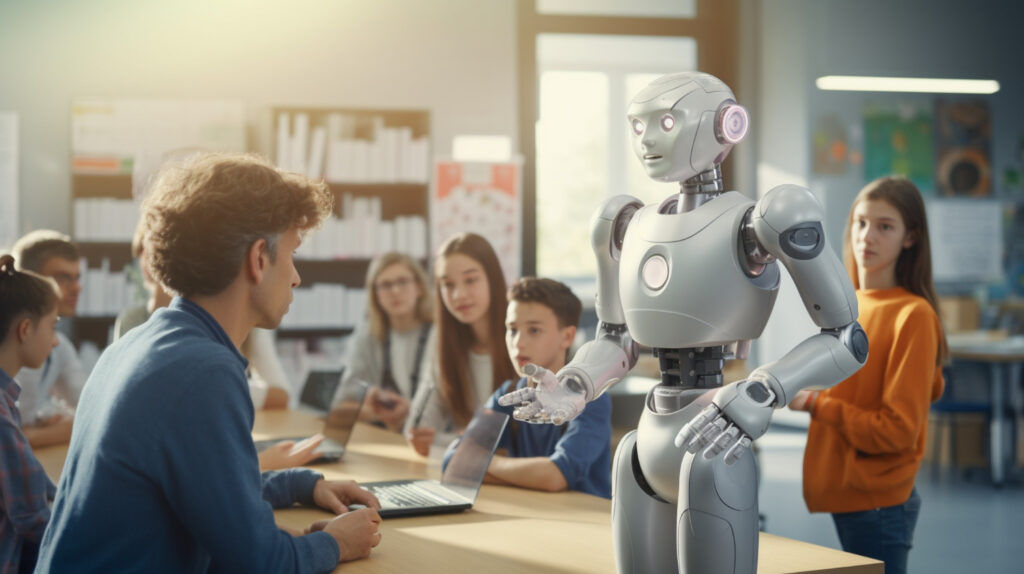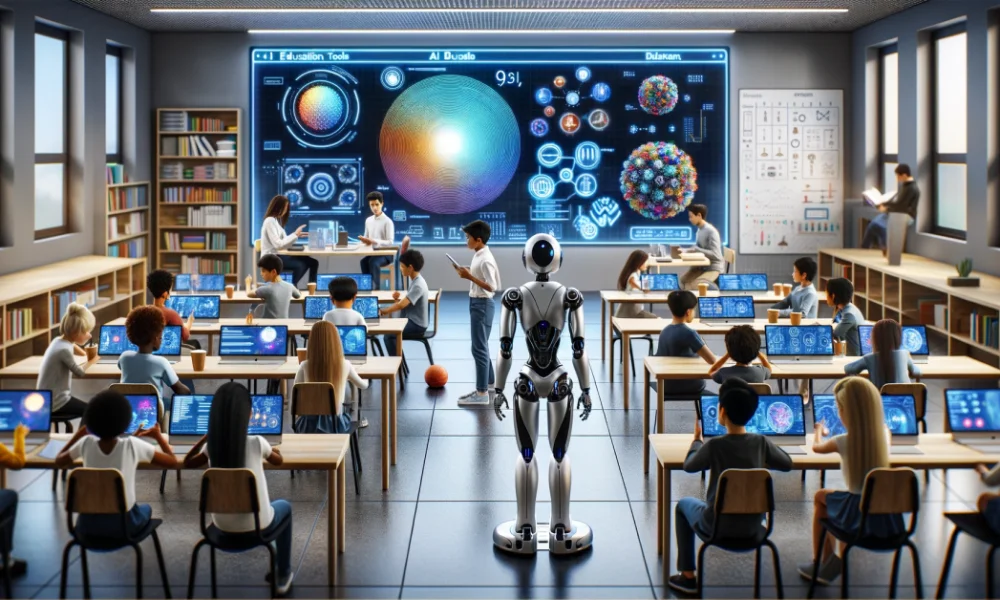Would you like to learn more about AI and its future in education?
Education is a fundamental component of society. Through the centuries, it has always been the gateway used by the coming generations to obtain the knowledge and abilities required to keep up with the changes taking place in the world. Along with the changing world, education must accommodate reality. Artificial Intelligence (AI) has rapidly become one of the most influential weapons dedicated to the creation of a future of education.
Artificial intelligence (AI) is referred to as the capacity for machines to imitate human behavior and learn from experience. This implies that in education, machines can empower students to learn faster and in a personalized way. Let’s begin by looking at how AI is impacting the education sector and how it is changing the dynamic of the future classroom.
1. Role of Artificial Intelligence in Education
1.1 Personalized Learning: Adapting Education to Individual Needs
Among the main benefits of AI in education is the capability of AI systems to provide personalized learning. Every student is an individual with different rates of learning and learning styles. AI in education closely analyzes student data and adapts at an individual level based on their preferences. This implies students can move forward at their own pace and receive the support required when needed.
1.2 Development of 21st- Century Skills
Education comprises both acquiring knowledge and developing skills. What kinds of skills in critical thinking, critical problem solving, and effective communication do AI prepare students for the 21st century skill set needed? Through simulations and interactive scenarios, students could have practical experience on how knowledge is being used in real life.
1.3 Data Analysis and Educational Predictions
AI leverages student data through the analysis of such materials as assignments and interaction, the examining of which allows establishing the patterns early and predicting the learning needs.
2. AI Algorithms and Technology

Imagine a super-powered study partner! Algorithms are the brains of AI systems, responsible for instructing and integrating AI to augment human abilities in thinking. Like students who need study materials to study for exams, AI algorithms make use of different kinds of data in their learning processes.
These data types include:
- Text: Articles, educational materials, and student essays too!
- Images: Diagrams, pictures of science lab, or historical events.
- Videos: Educational tutorials, simulations and student presentations.
2.1 AI Algorithms: Your Learning Guide
AI-based intelligent tools, such as
- Adaptive learning software,
- Automatic grading systems, and
- Virtual tutors/chatbots,
can ensure that students get personalized learning experiences, timely feedback and efficient appraisal of their skills, and constant support makes them in high demand among students.
2.2 The Rise of AI Systems and Software:
Traditional software is programmed with determined rules. Here’s the process:
Data Collection: For example, think of how you often collect information to study before a test. AI systems monitor student submissions, interactions with course resources, and the various educational materials learners are using.
AI Software Development: AI software development is on the mission of creating intelligent systems which can be learned and improved from data.
- Choosing the Right Tool: AI applies different strategies like selecting learning or way. Educators will select the best model to achieve the intended learning goals.
- Learning Through Examples: The AI system consumes this data, as you are solving math problems. Through its analysis, the AI finds patterns, for example, frequent errors in a certain math concept.
- Testing and Improving: The same way you look at your test scores, the performance of the AI system will also be checked. The existence of errors becomes a source of change, and the system becomes better.
2.3 Machine Learning, Deep Learning, and Neural Networks
- Unveiling the Techniques: Machine Learning, Deep Learning, and AI, have been proven to be adequate for more than simple pattern detection and can be applied to complex and random types of data.
- Machine Learning (ML): A type of algorithm that learns from data without being explicitly programmed. They are likely capable of improving their performance time as they have more data to analyze.
- Deep Learning (DL): A subfield of this branch in machine learning that is based on a structural human brain. The system involves ANNs with a multilayer form of processing information in a hierarchical manner.
- Neural Networks (NNs): The neural network is an artificial intelligence technique in which computers learn how to process information just like the human brain learns the pattern.
3. AI Applications in Various Fields
AI is reshaping many fields in our lives at an increasingly fast rate and quickly finding its way into our daily routines. Let’s take a closer look at some of these fascinating applications of AI and see how it is reshaping the future from various perspectives.
3.1 AI Applications in Autonomous Vehicles
AI-powered self-driving automobiles are leading the innovative explosion in the automobile sector. This brings about a safer, simpler and unique way of driving.
3.2 AI Applications in Customer Support
AI is changing customer service completely by providing customers with 24/7 assistance via chatbots and by employing sentiment analysis to find out customers’ needs. It also makes solving problems easier for businesses and makes their customers happy.
3.3 AI Applications on the Internet of Things (IoT)
Artificial intelligence performs key functions in managing the immense array of connected devices that comprise the Internet of Things. It enables data analysis from sensors and the utilization of obtained results to optimize energy usage in smart dwellings, predict maintenance needs in industrial operations, and personalize the connected experiences.
4. Generative AI: Communication and Machine Reform
AI is now a game changer; it generates content and automates tasks, which is like the real world. Machine learning can boost computer efficiency in tasks such as code and data generation. It can also enhance human interaction with the use of chatbots that utilize your preferences as the key.
5. Possible Dangers of AI
While AI might like as one of the most exciting technological developments in recent years, it is also essential to be an optimist and recognize not only potential dangers but also ethical concerns.
- Job Displacement: AI automation may lead to a decrease in job positions in certain industries. This could be dramatic changes in the students entering the working environment.
- Privacy Issues: AI systems that gather and analyze great amounts of data are the subject of discussions on privacy. Think educational programs that monitor student performance, it must be ensured that this data is safe and used appropriately.
6. The Importance of Responsible Development and Regulation:
- Transparency and Explainability: AI systems should be designed in a way that their decision-making processes are transparent. It consequently facilitates human control and safeguards the fairness and impartiality of the automated system.
- Human oversight: AI should be viewed as a tool for extending human abilities and not as a means of substitution. Teaching AI may individualize educational experience, but human teachers are relevant for mentoring, guidance, and maturation of social and emotional growth in students.
Conclusion
The landscape of education around the world is probably to experience dramatic change powered by the machinery of Artificial Intelligence (AI). From customized learning paths to interactive experiences, AI is ready to transform the educational ways in which you accomplish your goals. The future of AI in education is an open book. You have a pen in your hand to fill it!
Embracing the imagination, critical thinking, and observing ethical considerations can help you make sure AI is a favorable force in education, allowing you to learn, discover, and achieve your best in your education. Keep in mind the future of AI lies in your hands. It can go limitless branches.
“Artificial Intelligence is not a substitute for human intelligence; it is a tool to amplify human creativity and ingenuity.“
FAQs:
1. How is AI personalizing learning?
AI technologies can customize educational programs and make them suitable for each student’s data and learning method. Envision an AI tutor that modifies difficulties, suggests materials, and fits you with the most pertinent explanations as an example!
2. How will AI help develop 21st-century skills?
AI in education helps develop 21st-century skills by:
- Providing interactive simulations for real-world problem-solving in a practically.
- Develop personalized learning tracks to foster critical thinking in students.
- Instant feedback and specialists’ personalized learning resources.
- Promoting collaboration and community interactions, among others.
- Creating creativity with AI-infused tools.
3. How do AI algorithms work in education?
AI algorithms acquire knowledge from data such as texts (articles, essays), images (diagrams), and videos (tutorials). Based on this data, the algorithm locates the patterns and proposes appropriate learning resources or even anticipates where a student might need assistance.
4. What are some examples of AI applications in education?
- Adaptive learning platforms: These platforms customize learning paths based on individual student performance.
- Automatic grading systems: AI can analyze essays and offer constructive feedback, allowing teachers to manage more personalized or conversational forms of interaction.
- Virtual tutors/chatbots: These AI-driven tools provide unlimited access and answer student queries without any interruption.
5. What are some potential dangers of AI?
- Job displacement: Unemployment in the job market could increase because of AI automation in various sectors.
- Privacy concerns: The AI systems can acquire an excess amount of data and the privacy issues related to it. Besides, we should implement protection measures for student data and ensure their use ethically.






